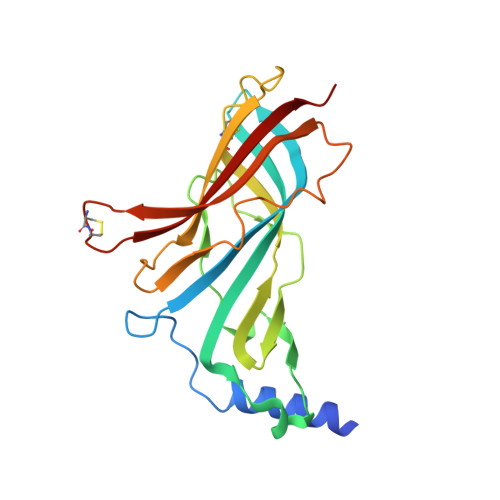The Cyclic Imine Core Common to the Marine Macrocyclic Toxins Is Sufficient to Dictate Nicotinic Acetylcholine Receptor Antagonism.
Bourne, Y., Sulzenbacher, G., Chabaud, L., Araoz, R., Radic, Z., Conrod, S., Taylor, P., Guillou, C., Molgo, J., Marchot, P.(2024) Mar Drugs 22
- PubMed: 38667766
- DOI: https://doi.org/10.3390/md22040149
- Primary Citation of Related Structures:
8Q1M, 8QTL, 8QX2 - PubMed Abstract:
Macrocyclic imine phycotoxins are an emerging class of chemical compounds associated with harmful algal blooms and shellfish toxicity. Earlier binding and electrophysiology experiments on nAChR subtypes and their soluble AChBP surrogates evidenced common trends for substantial antagonism, binding affinities, and receptor-subtype selectivity. Earlier, complementary crystal structures of AChBP complexes showed that common determinants within the binding nest at each subunit interface confer high-affinity toxin binding, while distinctive determinants from the flexible loop C, and either capping the nest or extending toward peripheral subsites, dictate broad versus narrow receptor subtype selectivity. From these data, small spiroimine enantiomers mimicking the functional core motif of phycotoxins were chemically synthesized and characterized. Voltage-clamp analyses involving three nAChR subtypes revealed preserved antagonism for both enantiomers, despite lower subtype specificity and binding affinities associated with faster reversibility compared with their macrocyclic relatives. Binding and structural analyses involving two AChBPs pointed to modest affinities and positional variability of the spiroimines, along with a range of AChBP loop-C conformations denoting a prevalence of antagonistic properties. These data highlight the major contribution of the spiroimine core to binding within the nAChR nest and confirm the need for an extended interaction network as established by the macrocyclic toxins to define high affinities and marked subtype specificity. This study identifies a minimal set of functional pharmacophores and binding determinants as templates for designing new antagonists targeting disease-associated nAChR subtypes.
- Lab "Architecture et Fonction des Macromolécules Biologiques" (AFMB), Aix-Marseille Univ, CNRS, Faculté des Sciences Campus Luminy, 13288 Marseille cedex 09, France.
Organizational Affiliation:


















